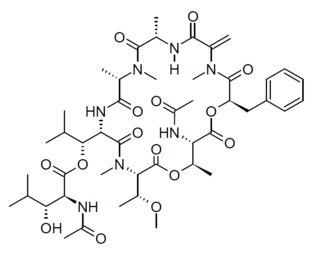Related Research Articles

Isatin, also known as tribulin, is an organic compound derived from indole with formula C8H5NO2. The compound was first obtained by Otto Linné Erdman and Auguste Laurent in 1840 as a product from the oxidation of indigo dye by nitric acid and chromic acids.

A bromodomain is an approximately 110 amino acid protein domain that recognizes acetylated lysine residues, such as those on the N-terminal tails of histones. Bromodomains, as the "readers" of lysine acetylation, are responsible in transducing the signal carried by acetylated lysine residues and translating it into various normal or abnormal phenotypes. Their affinity is higher for regions where multiple acetylation sites exist in proximity. This recognition is often a prerequisite for protein-histone association and chromatin remodeling. The domain itself adopts an all-α protein fold, a bundle of four alpha helices each separated by loop regions of variable lengths that form a hydrophobic pocket that recognizes the acetyl lysine.

François Diederich was a Luxembourgian chemist specializing in organic chemistry.
Dale Lester Boger is an American medicinal and organic chemist and former chair of the Department of Chemistry at The Scripps Research Institute in La Jolla, CA.

Monoamine oxidase B, also known as MAOB, is an enzyme that in humans is encoded by the MAOB gene.

Combretastatin A-4 is a combretastatin and a stilbenoid. It can be isolated from Combretum caffrum, the Eastern Cape South African bushwillow tree or in Combretum leprosum, the mofumbo, a species found in Brazil.
Bruce D. Roth is an American organic and medicinal chemist who trained at Iowa State University and the University of Rochester, and, at the age of 32, discovered atorvastatin, the statin-class drug sold as Lipitor that would become the largest-selling drug in pharmaceutical history. His honours include being named a 2008 Hero of Chemistry by the American Chemical Society, and being chosen as the Perkin Medal awardee, the highest honour given in the U.S. chemical industry, by the Society of Chemical Industry, American section in 2013.

Rhodanine is a 5-membered heterocyclic organic compound possessing a thiazolidine core. It was discovered in 1877 by Marceli Nencki who named it "Rhodaninsaure" in reference to its synthesis from ammonium rhodanide and chloroacetic acid in water.
Philip Salvatore Portoghese is an American medicinal chemist who has made notable contributions to the design and synthesis of ligands targeting opioid receptors. He is a Distinguished Professor of Medicinal Chemistry at the University of Minnesota, Twin Cities. He also served as the Editor-in-chief of the Journal of Medicinal Chemistry from 1972 to 2012, when the job was taken on by his departmental colleague, Gunda I. Georg, who shares the Editor-in-chief position with Shaomeng Wang at the University of Michigan.

Triptolide is a diterpenoid epoxide which is produced by the thunder god vine, Tripterygium wilfordii. It has in vitro and in vivo activities against mouse models of polycystic kidney disease and pancreatic cancer, but its physical properties and severe toxicity limit its therapeutic potential. Consequently, a synthetic water-soluble prodrug, minnelide, is being studied clinically instead.
Bromodomain-containing protein 9 is a protein that in humans is encoded by the BRD9 gene.
Peter Wipf is the distinguished university professor of chemistry at the University of Pittsburgh. His research interests focus on the total synthesis of natural products, the discovery of new transformations of strained molecules, and the development of new pharmaceuticals. He is a Fellow of the Royal Society of Chemistry (RSC), the American Association for the Advancement of Science (AAAS), and the American Chemical Society (ACS).
LeDock is a simple proprietary molecular docking software that can be used for docking of ligands with protein targets. LeDock supports running on 64-bit Linux, macOS, and 32-bit and 64-bit Windows.

James Inglese is an American biochemist, the director of the Assay Development and Screening Technology laboratory at the National Center for Advancing Translational Sciences, a Center within the National Institutes of Health. His specialty is small molecule high throughput screening. Inglese's laboratory develops methods and strategies in molecular pharmacology with drug discovery applications. The work of his research group and collaborators focuses on genetic and infectious disease-associated biology.

Michal Hocek is a Czech chemist. He is a group leader at the Institute of Organic Chemistry and Biochemistry of the Czech Academy of Sciences and a professor of organic chemistry at Charles University in Prague. He specializes in the chemistry and chemical biology of nucleosides, nucleotides, and nucleic acids.

Barry Victor Lloyd Potter MAE FMedSci is a British chemist, who is Professor of Medicinal & Biological Chemistry at the University of Oxford, Wellcome Trust Senior Investigator and a Fellow of University College, Oxford.
Peter Jonathan Rutledge is a New Zealand chemist and professor at the School of Chemistry, University of Sydney. His research has focused on drug development for tuberculosis, antibiotics, and metal sensing. He has engaged in some research activity on catalysis.

3CLpro-1 is an antiviral drug related to rupintrivir which acts as a 3CL protease inhibitor and was originally developed for the treatment of human enterovirus 71. It is one of the most potent of a large series of compounds developed as inhibitors of the viral enzyme 3CL protease, with an in vitroIC50 of 200 nM. It also shows activity against coronavirus diseases such as SARS and MERS, and is under investigation as a potential treatment agent for the viral disease COVID-19.
Katherine Seley-Radtke is an American medicinal chemist who specializes in the discovery and design of novel nucleoside or nucleotide based enzyme inhibitors that may be used to treat infections or cancer. She has authored over 90 peer-reviewed publications,is an inventor of five issued US patents, and is a Professor in the Department of Chemistry & Biochemistry at the University of Maryland, Baltimore County. Her international impact includes scientific collaborations, policy advising and diplomatic appointments in biosecurity efforts.

YM-254890 is a macrolide antibiotic derived from Chromobacterium species. It is used as a pharmacological research compound which acts as a selective inhibitor of Gq mediated signalling. However the claimed selectivity for Gq has been disputed.
References
- ↑ "Gunda I. Georg, PhD". College of Pharmacy - University of Minnesota. Retrieved 2020-03-06.
- ↑ "Three U of M Regents Professors named". umn.edu. Archived from the original on Sep 19, 2019. Retrieved September 4, 2019.
- ↑ "Editor". acs.org. Retrieved November 27, 2017.
- ↑ "Gunda Georg". umn.edu. Retrieved November 27, 2017.
- ↑ "Gunda Georg" . Retrieved November 27, 2017.
- ↑ "Gunda Georg". aaas.org. Archived from the original on December 1, 2017. Retrieved November 27, 2017.
- ↑ "MEDI Hall of Fame Inductees".
- ↑ "Alfred Burger Award in Medicinal Chemistry".
{{cite web}}: CS1 maint: url-status (link) - ↑ Wang, Linda. "ACS 2020 national award winners". Chemical & Engineering News.
{{cite web}}: CS1 maint: url-status (link) - ↑ "University of Minnesota scientists may have discovered a male birth control pill". startribune.com. Retrieved January 29, 2019.
- ↑ "Georg, Gunda". Emily Taylor Center for Women & Gender Equity. 2013-06-12. Retrieved 2020-03-06.
- ↑ "Gunda Georg". umn.edu. 2016-05-05. Retrieved November 27, 2017.
- ↑ "Project Information - NIH RePORTER - NIH Research Portfolio Online Reporting Tools Expenditures and Results". projectreporter.nih.gov. Retrieved 2020-03-06.
- ↑ "Georg Research Group - Research Projects". sites.google.com. Retrieved 2020-03-06.
- ↑ "NCBI MyBibliography". nih.gov. Retrieved September 4, 2019.
{{cite web}}: CS1 maint: url-status (link)